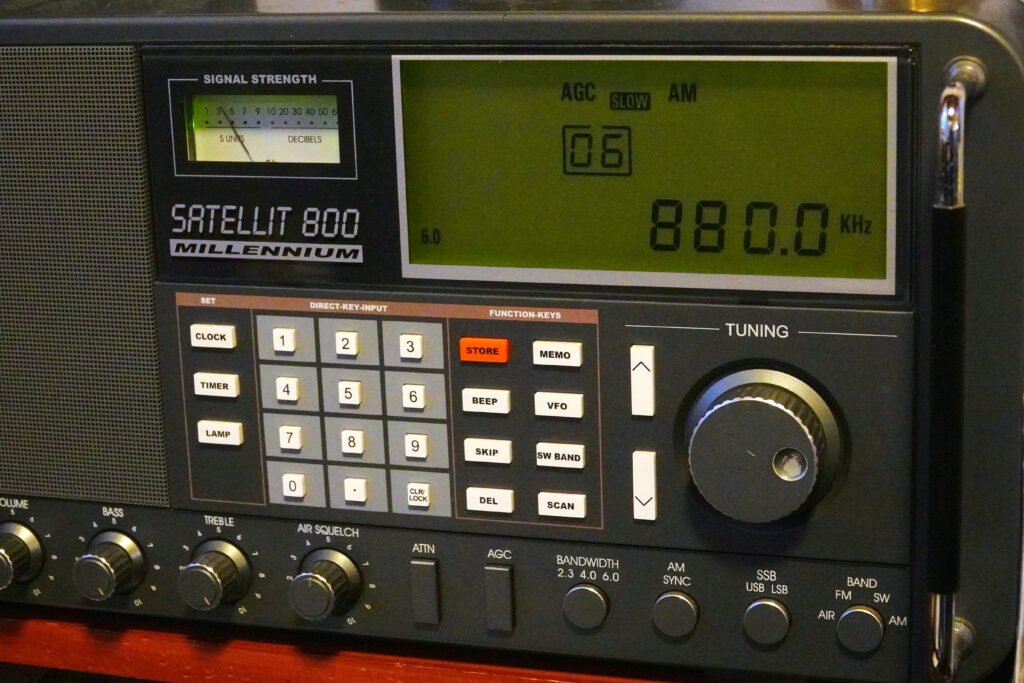By Jock Elliott, KB2GOM
First a word of acknowledgement and thanks: it was Chuck Rippel who said (in part) — in response to this post — “We could make this interesting by restricting listening to the period 10AM – 2PM maybe 3PM.” And that got me to thinking that maybe a daylight DXing challenge might be fun.
It was Bill Hemphill, who said, responding to the same blog post:
“Every year the New Jersey Antique Radio Club has a BCB DX contest for its club members. The main purpose is to encourage the members to put into operation some of the many old am radios that they own. This year’s contest was just completed this past Sunday. For any 24 hour period, using the same radio, you attempt to log the most distant stations. The contest score is the total mileage of the ten stations that are most distant.”
Reading that, I rather liked the idea of using mileage as one way to keep score.
Combining the two ideas, the result is The Great Medium Wave Daylight DX Challenge.
Here are the rules:
- Frequency rang is the medium wave band: 520-1710 kHz
- 10 am to 2 pm your local time on the Saturday after the post appears (Saturday, March 11, 2023).
- Any radio with any antenna, but must be the radio at your location (no using remote internet radios)
- The listener must hear the signal in real time
- The stations must be ID’ed by listening to the signal.
- Your report should include:
- Your name (or Internet handle)
- Your receiver and antenna (stay with the same setup from beginning to end; if you use multiple setups, provide a separate report for each).
- Your location
- The time, the frequency, and the ID of each station heard
- The total mileage of your top five most distant stations.
A final point: this is not a contest; it is a challenge. The reward for every participant will be fun and fellowship.
UPDATE: Chuck Rippel did sweeten the pot, though! Check out his generous offer here.


Where do we report our results for the MW challenge?
Jock will publish a post tomorrow where you comment with your reports.
That’s a nice idea, Jock!
I hereby disqualify myself from the competition on the grounds of having an unfair geographical advantage but mostly for the winter being back in my neck of the woods. Brrr 🙂 But the challenge sounds like fun, maybe it’ll be nice weather on Sunday and I’ll see what I can do with my new ultraportable MW rig for internal comparison. I hope someone with a GE SuperRadio wins! 🙂
13kda,
Thanks! I look forward to your results.
I hope lots of folks participate and have fun.
Cheers, Jock
Jock,
Would I be able to use my SDR and Loop-on-Ground at a Park??? I could capture station ID’s much easier that way. It is not a Vintage setup but had I wanted to test the setup on Mediumwave since I already know how well it works on shortwave.
TomL,
Absolutely! Any radio, any antenna, but it has to be at your location . . . not a remote internet radio.
You have to hear the signal in real time and ID the station from what you hear on the air . . . just like the old days, where you tune around and listen for an ID or clues to the ID.
Cheers, Jock
OK, thanks. I can do both, report only what I hear with my ears and then record, too, since the software allows me to “lock frequency” when recording. It allows me to roam around the dial while it is recording. 🙂
Will try my excersize sunday. I have my technician class that day. Sounds fun.
Michael,
Do it! The point is to have fun.
Cheers,Jock
http://www.heywhatsthat.com/profiler.html is a mapping program designed for the travel of radio waves between any two points on the spherical earth. Since the screen is flat you will find long distance paths are curved because the earth is a sphere. It also calculates Fresnel zone clearances for UHF and SHF signals.
You can specify addresses or latitude/longitudes. The FCC AM and FM radio databases contain transmitter co-ordinates.
Mangosman,
Thanks! A useful tool for calculating distances.
Cheers, Jock
Cool!
Sounds like fun! I have a single transistor regen tweaked to require no external antenna that provides outstanding daytime AM DX at headphone volume. Most of the time I’m QRM limited… [neighbor’s refrigerator, other line related crap, lightning crashes [summertime] etc.] On a quiet day I can easily bring in WBZ Boston, WGAN Portland ME is a bit more of a challenge but identifiable… etc. NYC stations sometimes..
One factor not included with the distance metric is that closer low power stations can be just as difficult
to copy. Perhaps a distance/divided by transmitter power would be a better metric…. but regardless,
this is a cool idea! My boss is a serious contender in the Amateur radio contesting world. He’ll get a kick out of my results. He’s been amazed by verifying the sensitivity of my little naked receiver at his house.
Cheers!
Terry,
Your rig sounds “righteous!”
I think idea of a difficulty metric is interesting, but let’s keep it simple for now.
And . . . I look forward to see what results you post.
I hope lots of folks take up and challenge and enjoy the heck out of it.
Cheers, Jock
Great idea, Jock! I will try to get this in my schedule!!
Cheers!
Robert,
Excellent!
Cheers, Jock